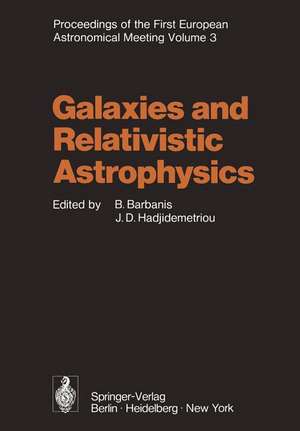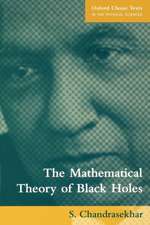Galaxies and Relativistic Astrophysics: Proceedings of the First European Astronomical Meeting Athens, September 4–9, 1972, Volume 3
Editat de B. Barbanis, J. Hadjidemetriouen Limba Engleză Paperback – 6 dec 2011
Preț: 640.71 lei
Preț vechi: 753.77 lei
-15% Nou
Puncte Express: 961
Preț estimativ în valută:
122.62€ • 126.67$ • 102.05£
122.62€ • 126.67$ • 102.05£
Carte tipărită la comandă
Livrare economică 25 martie-08 aprilie
Preluare comenzi: 021 569.72.76
Specificații
ISBN-13: 9783642656972
ISBN-10: 3642656978
Pagini: 264
Ilustrații: XII, 250 p.
Dimensiuni: 170 x 244 x 14 mm
Greutate: 0.43 kg
Ediția:Softcover reprint of the original 1st ed. 1974
Editura: Springer Berlin, Heidelberg
Colecția Springer
Locul publicării:Berlin, Heidelberg, Germany
ISBN-10: 3642656978
Pagini: 264
Ilustrații: XII, 250 p.
Dimensiuni: 170 x 244 x 14 mm
Greutate: 0.43 kg
Ediția:Softcover reprint of the original 1st ed. 1974
Editura: Springer Berlin, Heidelberg
Colecția Springer
Locul publicării:Berlin, Heidelberg, Germany
Public țintă
ResearchDescriere
In the twenties the new atomic physics opened the way toward a quantitative interpretation of stellar spectra. It was one of the aims in this new branch of astrophysics to determine in a quantitative way the chemical composition of stellar atmospheres, i. e. of those parts of the stars which are accessible to spectro scopic observation. It was only in the forties that the first reasonably accurate and complete analyses became available. In the meantime nuclear physics and the theory of the internal constitution of the stars had reached the important conclusion that the main sequence of the Hertzsprung-Russell-diagram is taken up by stars which in their central parts produce energy by the conversion of hydrogen into helium. It was BAADE who in the early fifties stimulated observational and theoretical work concerning the colour-magnitude-diagrams of star clusters and their connection with the nuclear evolution of stars. Obviously, this type of research opened also the way towards much more difficult and far reaching fields of research: the formation of galaxies and the origin of the chemical elements and their abundance distributions.
Cuprins
Observational and Theoretical Aspects of Galaxies.- Recent Radio Work in Nearby Galaxies.- Neutral Hydrogen Observations of External Galaxies with the Mark IA Radio Telescope.- The H I Distribution in Nearby Galaxies.- Compact Structures Associated with the Radio Galaxies 3C 66, 264 and 315.- Recent Optical Studies on Nearby Galaxies.- Gas Motions in the Nuclei of Seyfert Galaxies.- Electronographic Observations of the Optical Structure of Radio Galaxies.- The Magellanic Clouds.- Galactic Nuclei.- Galactic Nuclei.- The Chemical Evolution of the Galaxies.- The Theory of Spiral Structure. Resonances.- On Spiral Generating.- On the Possible Role of the Stellar Drift Motions for the Dynamics and Structure of Differentially Rotating Stellar Systems.- The Dynamics of Nearby Galaxies.- Structural Changes in Globular Galaxies due to Collisions.- Waves in Rotation Curves of Galaxies as Population Effects.- On Galaxy Parameters as Derived from Primeval Turbulence.- Evidence for the Existence of Second-Order Clusters of Galaxies.- Relativistic and High Energy Astrophysics.- The Stability of Stellar Masses in General Relativity.- Remarks on Schwarzschild Black Holes.- Classical Fields in the Vicinity of a Schwarzschild Black Hole.- Stability of Non-Radial Vibrational Modes of Relativistic Neutron Stars.- On Some Properties of Relativistic MHD Flows.- Astrophysical Implications of Extragalactic Radio Sources.- Pulsars.- High Resolution 21-cm Observations of Tycho’s Supernova Remnant.- Radio Filaments in the Crab Nebula from High Resolution Maps.- A Model of the Crab Nebula Derived from Dual-Frequency Radio Measurements.- On the Possible Detection of an Energetic Photon Pulse from the Recent Supernova in NGC 5253.- Relevance of Electron Pair Production in the Interpretation of IR and X Extragalactic Sources.- Author Index.















